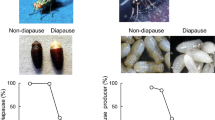Summary
The European corn borer (Ostrinia nubilalis) diapauses as a last instar larva. Both induction and termination of diapause are photoperiodically controlled. Larvae enter diapause (Fig. 1) when raised in light cycles containing 12 or 13 h of light per 24 h (LD 12∶12 or LD 13∶11). When placed in LD 16∶8, diapausing larvae undergo pupation and adult development (Fig. 2, 3).
Long light cycle (T) experiments demonstrate that the timing mechanism involved in terminating diapause has the properties of an interval timer or hourglass mechanism (Fig. 4). Six inductive 8-h dark phases are necessary for optimal termination (Fig. 5), and they must be coupled with at least 4 h of light per cycle (Fig. 6). The circadian system inOstrinia is probably not involved in any way in this response.
Similar content being viewed by others
References
Adkisson, P.L.: Internal clocks and insect diapause. Science154, 234–241 (1966)
Beck, S.D.: Photoperiodic induction of diapause in an insect. Biol. Bull.122, 1–12 (1962)
Beck, S.D.: Insect photoperiodism, pp. 288. New York and London: Academic Press 1968
Bissonnette, T.H.: Modification of mammalian sexual cycles. Reactions of ferret (Putorius vulgaris) of both sexes to electric light added in November and December. Proc. roy. Soc. B110, 382 (1932)
Bown, M.F., Skopik, S.D.: Insect photoperiodism: The “T” experiment as evidence for an hourglass mechanism. Science192, 59–60 (1976)
Brindley, T.A., Sparks, A.N., Showers, W.B., Guthrie, W.D.: Recent research advances on the European corn borer in North America. Ann. Rev. Entomol.20, 221–239 (1975)
Bünning, E.: Die endogene Tagesrhythmik als Grundlage der photoperiodischen Reaktion. Ber. dtsch. bot. Ges.54, 590–607 (1936)
Curl, G.D., Burbutis, P.P., Davis, C.P.: Rearing the European corn borer,Ostrinia nubilalis (Hübner) (Lepidoptera: Pyralidae) on a lima bean medium. J. New York entomol. Soc.83, 265–266 (1975)
Danilevskii, A.S.: Photoperiodism and seasonal development of insects, pp. 283 London: Oliver and Boyd 1965
Garner, W., Allard, H.A.: Effect of the relative length of day and night and other factors of the environment on growth and reproduction in plants. J. Agr. Res.18, 553–606 (1920)
Hammer, K.C., Hoshizaki, T.: Photoperiodism and circadian rhythms: An hypothesis. BioScience24, 407–414 (1974)
Lees, A.D.: Is there a circadian component in theMegoura photoperiodic clock? In: Circadian clocks (ed. Aschoff), pp. 351–356. Amsterdam: North Holland Publ. Co. 1965
Lees, A.D.: Photoperiodic timing mechanisms in insects. Nature (Lond.)210, 986–989 (1966)
Lees, A.D.: The role of circadian rhythmicity in photoperiodic induction in animals. In: Proceedings of international symposium on circadian rhythmicity, pp. 87–110. Wageningen, The Netherlands: Pudoc Press 1971
Marcovitch, S.: The migration of Aphidae and the appearance of sexual forms as affected by the relative length of daily light exposure. J. Agr. Res.27, 513–522 (1924)
McLeod, D.G.R., Beck, S.D.: Photoperiodic termination of diapause in an insect. Biol. Bull.124, 84–96 (1963)
Minis, D.H.: Parallel peculiarities in the entrainment of a circadian rhythm and photoperiodic induction in the pink boll worm (Pectinophora gossypiella). In: Circadian clocks (ed. J. Aschoff), pp. 333–343. Amsterdam: North Holland Publ. Co. 1965
Nanda, K.K., Hamner, K.C.: Studies on the nature of the endogenous rhythm affecting photoperiodic response of Biloxi soybean. Bot. Gaz. (Chic.)120, 14–25 (1958)
Pittendrigh, C.S.: On the mechanism of the entrainment of a circadian rhythm by light cycles. In: Circadian clocks (ed. J. Aschoff), pp. 277–297. Amsterdam: North Holland Publ. Co. 1965
Pittendrigh, C.S.: The circadian oscillation inDrosophila pseudoobscura pupae: A model for the photoperiodic clock. Z. Pflanzenphysiol.54, 275–307 (1966)
Pittendrigh, C.S.: Circadian surfaces and the diversity of possible roles of circadian organization in photoperiodic induction. Proc. nat. Acad. Sci. (Wash.)69, 2734–2737 (1972)
Pittendrigh, C.S.: Circadian oscillations in cells and the circadian organization of multicellular systems. In: The neurosciences, third study program (eds. F.O. Schmitt, F.G. Worden), pp. 437–458. Cambridge: M.I. T. press 1974
Pittendrigh, C.S., Minis, D.H.: The entrainment of circadian oscillations by light and their role as photoperiodic clocks. Amer. Nat.98, 261–294 (1964)
Pittendrigh, C.S., Minis, D.H.: The photoperiodic time measurement inPectinophora gossypiella and its relation to the circadian system in that species. In: Biochronometry (ed. M. Menaker), pp. 212–250. Wash., D.C.: Nat. Acad. of Sci. 1971
Rowan, W.: On photoperiodism, reproductive periodicity and the annual migration of birds and certain fishes. Proc. Boston Soc. Nat. Hist.38, 147–189 (1926)
Saunders, D.S.: Circadian rhythms and photoperiodism in insects. In: The physiology of insecta (ed. M. Rockstein) Vol. II, 2nd. ed., pp. 461–533. New York and London: Academic Press 1974
Skopik, S.D., Pittendrigh, C.S.: Circadian systems, II. The oscillation in the individualDrosophila pupa; its independence of developmental stage. Proc. nat. Acad. Sci. (Wash.)58, 1862–1869 (1967)
Truman, J.W.: The role of the brain in the ecdysis rhythm of silkmoths: Comparison with the photoperiodic termination of diapause. In: Biochronometry (ed. M. Menaker), pp. 483–504. Wash., D.C.: Nat. Acad. of Sci. 1971 a
Truman, J.W.: Hour-glass behavior of the circadian clock controlling eclosion of the silkwormAntheraea pernyi. Proc. nat. Acad. (Wash.)68, 595–599 (1971 b)
Author information
Authors and Affiliations
Additional information
We are especially indebted to Dr. Milton H. Stetson for many stimulating discussions, suggestions, and his critical reading of the manuscript. We also benefited greatly from discussions with Dr. Paul Burbutis, Mr. Gary Curl and Dr. N.G. Patel. The former two saved us numerous hours of work by generously supplying us with eggs and teaching us the rearing technique forOstrinia. This work was supported by a grant from the UNIDEL Foundation to the Department of Biological Sciences.
Rights and permissions
About this article
Cite this article
Skopik, S.D., Bowen, M.F. Insect photoperiodism: An hourglass measures photoperiodic time inOstrinia nubilalis . J. Comp. Physiol. 111, 249–259 (1976). https://doi.org/10.1007/BF00606467
Received:
Issue Date:
DOI: https://doi.org/10.1007/BF00606467




